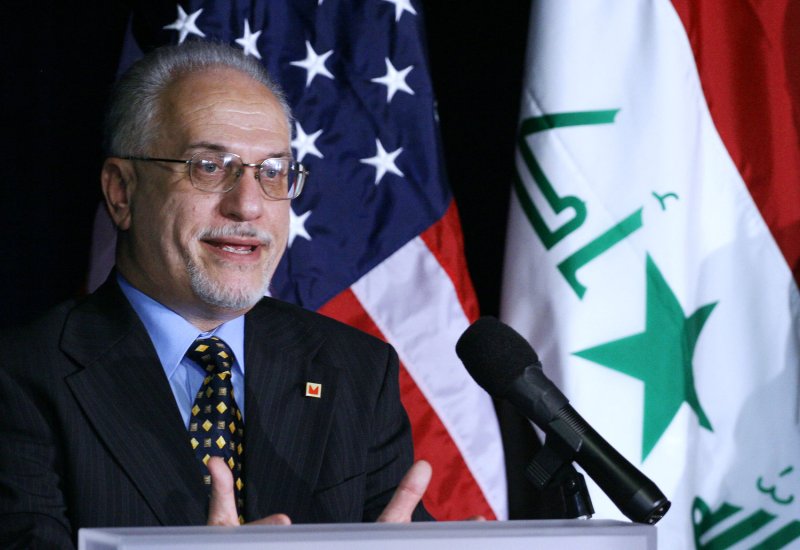Iraqi Minister of Oil Hussein al-Shahristani answers reporters' questions at a joint press conference with the U.S. Energy Department Secretary at the Energy Department in Washington on July 26, 2006. The bureaucrats spoke of reestablishing Iraq's crude oil production to prewar levels and of establishing strategic partnerships between the two countries' energy sectors. (UPI Photos/Eduardo Sverdlin) |
License Photo
BAGHDAD, Dec. 9 (UPI) -- Iraq is concentrating its drive to quadruple its oil output on its six "super fields," which analysts say have the potential to produce in excess of 10.5 million barrels a day by 2017.
That's just short of the Oil Ministry's declared target of up to 12 million bpd in the next six years. There is a lot of skepticism in the global oil industry that Iraq will be able to meet such an ambitious target that would challenge Saudi Arabia's supremacy.
But in recent months, some of the foreign oil companies awarded 20-year production contracts at the Super Six -- Rumaila, West Qurna 1, West Qurna 2, Majnoon, Zubair and Halfaya -- in 2009 have generally reported production increases.
Dhiya Jafaar, director of the Iraq's state-run South Oil Co., reported in November that production in the region, which contains two-thirds of Iraq's known reserves, was running at 1.68 million barrels per day and was expected to reach 1.82 million bpd by the end of the year.
The Super Six, which between them hold around 74 percent of Iraq's reserves, are key to Oil Minister Hussein al-Shahristani's plan to boost production to bankroll postwar reconstruction.
Here's how these major fields are performing, with projected production increases:
Rumaila: Iraq's biggest field with the equivalent of 17.8 billion barrels of oil. That makes it the fourth largest oil field in the world. It contains around 15 percent of Iraq's oil. It is operated by BP and the China National Petroleum Corp.
Production is 1.052 million bpd and is expected to reach its initial production rate of 1.065 million bpd by the end of the year, Jafaar says. That's three years ahead of schedule.
West Qurna 1: Contains 8.7 billion barrels. Exxon Mobil of the United States and Royal Dutch Shell secured the production contract in 2009. Production has been slipping but is expected to hit the IPR of 285,000 bpd within a year.
West Qurna 2: Holds 12.9 billion barrels and is operated by a consortium headed by Russia's Lukoil and StatoilHydro of Norway. Peak production of 1.8 million bpd is expected by the end of 2012, sustainable for more than a decade.
Majnoon: With reserves of 12.6 billion barrels, this is one of the top Iraqi fields and lies near the border with Iran. It is operated by Royal Dutch Shell and Petronas, which say they have boosted production from a paltry 46,000 bpd to 70,000 bpd, rising eventually to 1.8 million bpd.
Zubair: Operated by a consortium of Italy's ENI, the U.S. Occidental Petroleum Corp. and the Korea Gas Corp. of South Korea. It has reserves of 4.1 billion barrels. Production is 200,000 bpd, up from 183,000 bpd in 2009. That's expected to eventually reach 1.2 million bpd.
Halfaya: Contains 4.1 billion barrels and is operated by the China National Petroleum Corp. Production is running at 3,600 bpd but potential output has been pegged as high as 535,000 bpd.
The Baghdad government expects production from just three of these fields -- Rumaila, West Qurna 2 and Zubair -- to hit 7 million bpd within six years.
Following the arrival of the foreign companies, with their advanced exploration and drilling equipment, including 3-D seismic surveys, Iraq was able to determine its reserves with much greater accuracy than in the past.
In October, Baghdad raised its proven oil reserves from 115 billion barrels to 143.1 billion barrels largely on the companies' upgraded assessments. That's an increase of 24 percent.
The sharp rise in reserves wasn't unexpected. There had been no exploration work conducted for two decades and reserves data were largely based on outdated technology.
Energy analysts estimate that Iraq may have another 100 billion barrels of oil in untapped reserves.
The Iraqis say the modern technology that's now coming in will squeeze out more oil than was previously thought possible.
"Iraq's reserves lie in a few huge fields that have not been fully explored since the early 1970s," observed Colin Lothian of Wood Mackenzie, the international energy consultancy.
"Iraq's current reserves estimate … will rise significantly in the next decade. The potential exists that Iraq could rival Saudi Arabia, but much will have to happen before that."















